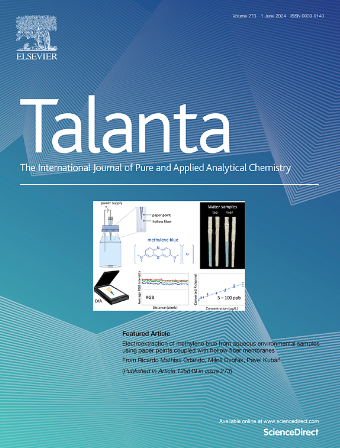Dual nanozyme based on ultrathin 2D conductive MOF nanosheets intergraded with gold nanoparticles for electrochemical biosensing of H2O2 in cancer cells.
IF 5.6
1区 化学
Q1 CHEMISTRY, ANALYTICAL
引用次数: 28
Abstract
The development of facile, rapid and cost-effective strategies for sensitive detection of cancer biomarkers in human samples is of great significance for early diagnosis of malignant tumors related diseases. In this work, we develop a high-performance electrochemical biosensor based on highly active dual nanozyme amplified system, i.e., ultrathin two-dimension (2D) conductive metal-organic framework (C-MOF) nanosheets (NSs) decorated with high-density ultrafine gold nanoparticles (Au-NPs), and explore its application in sensitive detection of cancer biomarker H2O2 in live cells. The C-MOF NSs {i.e., Cu-HHTP (HHTP = 2,3,6,7,10,11-hexahydroxytriphenylene)-NSs} provide large surface area and abundant active open metal sites (Cu-O4), which could improve the catalytic activity of Cu-HHTP-NSs towards H2O2. Moreover, abundant exposed O atoms also serve as anchor sites for the deposition of high-density ultrafine Au-NPs (∼3 nm) without agglomeration. Owing to the synergistic contributions of high catalytic activity of Cu-HHTP-NSs and Au-NPs as well as their unique structural and electrical properties, the as-prepared nanohybrid modified electrode exhibits good sensing performances to H2O2 with an extremely low detection limit of 5.6 nM (3σ rules) and a high sensitivity of 188.1 μA cm-2 mM-1. Furthermore, the proposed nanozymatic electrochemical biosensor has been applied in real-time tracking H2O2 released from different human colon cells to identify colon cancer cells from normal colon epithelial cell, which demonstrates its great prospect for early diagnosis and management of various cancer diseases.基于超薄二维导电MOF纳米片与金纳米粒子集成的双纳米酶用于癌细胞中H2O2的电化学生物传感。
开发简便、快速、高性价比的人体肿瘤生物标志物敏感检测策略,对恶性肿瘤相关疾病的早期诊断具有重要意义。在本工作中,我们开发了一种基于高活性双纳米酶扩增系统的高性能电化学生物传感器,即高密度超细金纳米粒子(Au-NPs)修饰的超薄二维(2D)导电金属有机框架(C-MOF)纳米片(NSs),并探索其在活细胞中癌症生物标志物H2O2的灵敏检测中的应用。C-MOF NSs{即, Cu-HHTP (HHTP = 2,3,6,7,10,11-六羟基三苯)-NSs}提供了大的表面积和丰富的活性开放金属位(Cu-O4),这可以提高Cu-HHTP-NSs对H2O2的催化活性。此外,大量暴露的O原子也可以作为高密度超细Au-NPs (~ 3 nm)无团聚沉积的锚位点。由于cu - htp - nss和Au-NPs的高催化活性协同作用以及它们独特的结构和电学性能,所制备的纳米杂化修饰电极对H2O2具有良好的传感性能,检测限极低,为5.6 nM (3σ规则),灵敏度高达188.1 μA cm-2 mM-1。此外,所提出的纳米酶电化学生物传感器已被应用于实时跟踪不同人类结肠细胞释放的H2O2,从正常结肠上皮细胞中识别结肠癌细胞,这表明其在各种癌症疾病的早期诊断和治疗中具有广阔的前景。
本文章由计算机程序翻译,如有差异,请以英文原文为准。
求助全文
约1分钟内获得全文
求助全文
来源期刊

Talanta
化学-分析化学
CiteScore
12.30
自引率
4.90%
发文量
861
审稿时长
29 days
期刊介绍:
Talanta provides a forum for the publication of original research papers, short communications, and critical reviews in all branches of pure and applied analytical chemistry. Papers are evaluated based on established guidelines, including the fundamental nature of the study, scientific novelty, substantial improvement or advantage over existing technology or methods, and demonstrated analytical applicability. Original research papers on fundamental studies, and on novel sensor and instrumentation developments, are encouraged. Novel or improved applications in areas such as clinical and biological chemistry, environmental analysis, geochemistry, materials science and engineering, and analytical platforms for omics development are welcome.
Analytical performance of methods should be determined, including interference and matrix effects, and methods should be validated by comparison with a standard method, or analysis of a certified reference material. Simple spiking recoveries may not be sufficient. The developed method should especially comprise information on selectivity, sensitivity, detection limits, accuracy, and reliability. However, applying official validation or robustness studies to a routine method or technique does not necessarily constitute novelty. Proper statistical treatment of the data should be provided. Relevant literature should be cited, including related publications by the authors, and authors should discuss how their proposed methodology compares with previously reported methods.
 求助内容:
求助内容: 应助结果提醒方式:
应助结果提醒方式:


